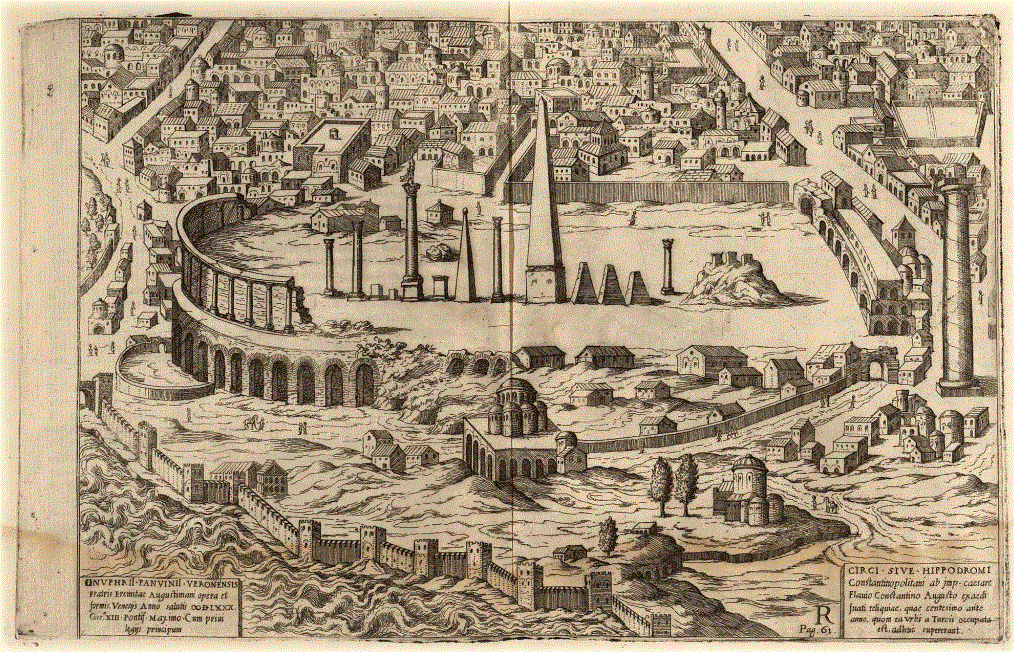Monuments of Constantinople
Today there are several monuments dating to an early period of Constantinople. They belong to a practice inherited from the city of Rome. By setting up honorific columns, triumphal arches and obelisks, emperors like Constantine and Theodosius emphasized the Romanitas (Romanness) of the new capital. It was also part of a broader attempt to rival the city of Rome.
Even though Constantinople would never match the number, size and splendor of Rome’s honorific monuments, there are several noteworthy examples of similar monuments in Istanbul today. The most prominent are the Column of Constantine and the Obelisk of Theodosius, which are better known due in part to being located in popular touristic areas of the city. In addition, the Column of Marcian, Column of the Goths and the Masonry Obelisk are still standing, while remains of the Serpent Column, Arch of Theodosius, Column of Theodosius, Column of Arcadius and the Milion can also still be seen in situ. The Column of Justinian, now lost, was one of many honorific columns located in the Augustaion, which also included a column erected in honor of Helena. The remains of honorific monuments can also be found in the Istanbul Archaeological Museums as well as in the gardens of Hagia Sophia and Topkapı Palace.
Columns and Monuments
Column of Arcadius
Column of Marcian
Column of the Goths
Column of Theodosius II (in Hebdomon)
Monuments of the Hippodrome
Streets and Forums
Forum Bovis
Public Buildings
Baths of Zeuxippus
Philadelphion
Historical Background of Honorific Monuments
Starting in the Republican era, arches and columns crowned statues were commonly erected in Rome in honor of particular individuals. As Pliny records, they raised the individual honored “above the rest of the mortals”. By the Imperial era, such monuments were often part of major imperial building projects meant to both improve the quality of life for Roman citizens and aggrandize the image of the emperor.
Perhaps the most important form of commemorative architecture was the honorific arch, which eventually could be found throughout the empire. Triumphal arches in the city of Rome were often located along the route of the triumphal procession and typically carried a statue group with a victorious emperor riding a quadriga (the four-horse chariot). The best example of the single arch in Rome is the Arch of Titus, which was built to celebrate his conquest of Jerusalem in 70. Over time, arches became increasingly elaborate as seen in the triple arch of Septimius Severus built in 203 AD.
A large number of honorific columns were erected over the course of Rome’s history. Several columns, for example, were erected on or near the Rostra Augusti in the Roman Forum. The Column of Trajan, which was erected in the Forum of Trajan in 113 AD, is the most important honorific column in the city of Rome. It had elaborate sculpted reliefs spiraling around the column depicted his entire campaign in Dacia, with a statue of Trajan was placed atop the column. It served as the model for not only the Column of Marcus Aurelius, but also for the Column of Theodosius and the Column of Arcadius in Constantinople almost three centuries later.
The significance of Rome diminished by the Tetrarchic era, when emperors began to resided in various cities like Nicomedia, Thessaloniki and Milan. Honorific monuments were often set up as part of imperial building projects in the Tetrarchic ‘capitals’, as can be seen in the Arch of Galerius in Thessaloniki. However honorific monuments continued to be built in the city of Rome for several centuries. A set of five honorific columns made of Aswan granite were erected in 303 AD when Diocletian visited to celebrate the twentieth year of his reign and the tenth year of the Tetrarchy. The Arch of Constantine was set up in Rome on the tenth anniversary of Constantine’s reign in 315. Arches continued to be built through the 5th century in Rome. An arch dedicated to the emperors Gratian, Valentinian and Theodosius was built between 379 and 383, while another arch dedicated to the emperors Arcadius, Honorius and Theodosius was erected in Rome after Stilicho’s defeat of the Goths in 405. Constantius also erected an obelisk on the spina the Circus Maximus in 357 AD, following the lead of Augustus who erected an obelisk there in 10 BC following his defeat of Anthony and Cleopatra. The last monument added to the Roman Forum was the Column of Phocas erected in 608.
Nonetheless Constantinople became the major benefactor of imperial patronage, even when it was not a regular imperial residence from Constantine’s death until Theodosius I moved there in 380. While major investment in infrastructure slow came to an end in Rome, it continued at Constantinople even during this period. Honorific monuments were part of these construction projects, which accompanied the construction of fora, aqueducts and other public works meant to aggrandize the new capital. These monuments were an integral part of Constantinople’s attempt to emulate and rival the city of Rome.
Also see Roman Honorific Monuments
Columns of Constantinople

16th century engraving by Onofrio Panvinio

Based on map by Magdalino
Sources
A New Topographical Dictionary of Ancient Rome by L. Richardson, Jr.
Ancient Greece and Rome edited by Michael Gagarin
A Dictionary of the Roman Empire by Matthew Bunson
Oxford Dictionary of Byzantium edited by Alexander Kazhdan
The Oxford Handbook of Greek and Roman Art and Architecture edited by Clemente Marconi
Two Romes: Rome and Constantinople in Late Antiquity edited by Grig and Kelly
Rome: An Oxford Archaeological Guide by Amanda Claridge
Roman Architecture by Frank Sear
Resources
Columns and Monuments of Constantinople Photo Album (Byzantine Legacy Flickr)













